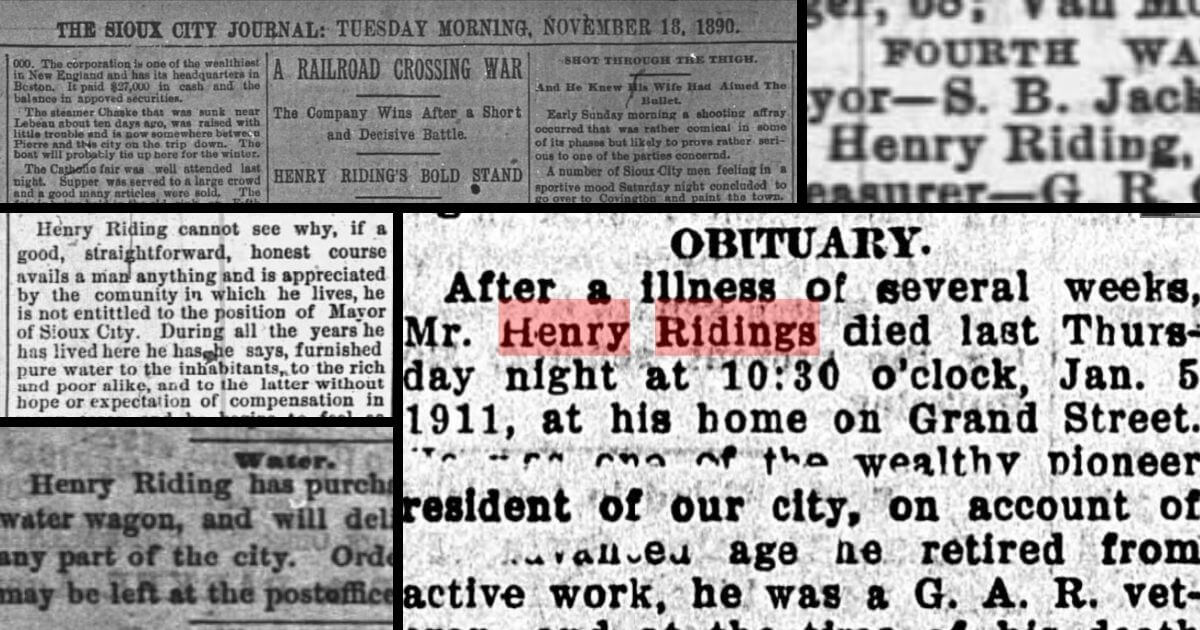
Compiled from Library of Congress Archives, Newspapers.com screenshots
Henry Riding—spelled Ridings in some instances—was born into enslavement in Missouri and died as the wealthiest Black man in Sioux City.
Born in Lexington, Missouri, in 1839, Riding literally fought for his freedom as a Union soldier during the Civil War. He served in the 1st Kansas Colored Infantry Regiment, the first Black unit to see combat in the war.
After his service, Riding moved to Sioux City. He saw a business opportunity to serve an influx of Black railroad and steamboat workers passing through the Missouri River community.
Riding quickly made a name for himself in Sioux City. He was featured frequently in the pages of the Sioux City Journal in the 1870s, including a story about someone stealing his buffalo robe and a lawsuit between him and neighbor over nine hogs.
His obituary says he “made many friends among both white and colored by his pleasant ways.” An 1871 Journal article noted his dances attracted Black and white attendees.
Riding opened a hotel—utilized by mostly Black workers—near the Chicago & North Western railroad depot—located around the 200 block of Nebraska Street—in the late 1800s where he “earned a substantial living.”
This business allowed him to become Sioux City’s wealthiest Black man, according to “Outside In: African-American History in Iowa 1838-2000.” The Sioux City Journal took it a step further and called him one of the “wealthiest negroes in Iowa.”
Although he was known for his “pleasant ways,” Riding also was not a man to take lightly. In November 1890, a shotgun-wielding Riding threatened railroad employees as they laid tracks on his property without his permission since no deal had been reached yet.
“I am not an obstructionist and I am not asking the Sioux City and Northern an exorbitant price for my property…,” Riding told the Sioux City Journal. “I only want what my lot is worth, and this the company has not offered me.”
According to the Isabella County Enterprise’s blurb of the incident, Riding wanted $85,000 from the railroad to lay track across one of his lots that was appraised for $17,000.
The Enterprise reported that Riding was “pounded almost to death by the police and then locked up.” A detailed report about the altercation from the Journal said it took three officers to bring Riding in. It described him as “a man of enormous physical strength” who “jerked the two officers around as if they had been a couple of 10-year-olds boys” before a third officer entered the fray and dazed him with a blow to the forehead and a second hit that knocked him unconscious.
According to “Outside In,” Riding was eventually awarded $21,000 by the railroad to lay tracks across his land.
Riding deposited his new railroad money in Thomas J. Stone’s bank, which failed shortly after. According to “Outside In,” “Riding did not accept this fact, and, with gun in hand, challenged the bank and got his money back!”
“Outside In” estimated Riding’s net worth in 1903 at $85,000, which is about $2.7 million in 2022. His hotel money and railroad payment helped bolster his fortune, but Riding also had other investments including additional real estate, a water delivery wagon, a stable, and a saloon to name a few.
In an 1877 Journal article, Riding suggested he should be the mayor of Sioux City.
“During all the years he has lived here he has, he says, furnished pure water to the rich and poor alike, and to the latter without hope or expectation of compensation in many cases, and he begins to feel as though the people ought to do something for him in the way of a good fat office.”
Riding did in fact run for mayor in the 1879 Sioux City municipal election. He received a single vote. More than 100 years would go by before a Black person was elected as mayor of an Iowa city. The first was Al Saunders who won the Marble Rock mayoral contest in 1991.
Riding was also active in fighting for civil rights. He was a member of the Afro-American Protective Association of Iowa, which was essentially the NAACP before there was an NAACP. Riding served in various roles including being a Sioux City delegate during annual meetings and even being elected as state treasurer for a spell.
Other prominent Black Iowans of the time involved in the organization include Des Moines businessman and inventor Robert Nelson Hyde, and Alexander Clark Jr., whose father helped desegregate Iowa schools in 1868. The younger Clark was the first Black man to graduate from the University of Iowa Law School and later practiced law in Oskaloosa.
After an illness that lasted several weeks, Riding died at 72 on Jan. 5, 1911. He was buried in the Old Soldiers section of the Floyd Cemetery. Riding had purchased his plot and gravestone years before dying, which some thought was slightly unusual because he was perfect in health and because of the stone’s unique look.
According to his obituary, Riding had $40,000 when he died, which is about $1.1 million in 2022. His estate left money for Sioux City’s two Black churches; his brothers, nephews, cousins, and nieces; and the Grand Army of the Republic, a defunct Civil War veterans fraternal organization.
The Jan. 13, 1911, edition of the Iowa State Bystander newspaper asked people to look for Riding’s cousin, Charles Beebins, who had last been spotted in Des Moines. The final line of the Bystander brief explains why it was so important to track Beebins down: “A fortune awaits him in Sioux City, Iowa.”
by Ty Rushing
02/25/22

Iowa Republicans make outlawing gay marriage key 2024 campaign priority
Iowa Republicans have made outlawing gay marriage a key goal in their 2024 party platform. During the Iowa GOP’s 2024 state convention on Saturday,...

Department of Justice says Iowa immigration law violates US Constitution
If Iowa doesn’t suspend the enforcement of its new immigration law by May 7, the state could face a federal lawsuit, according to the Des Moines...

Rushing: Iowa State president said the quiet part out loud
I want to thank Iowa State University President Wendy Wintersteen for doing us all a favor by finally saying the quiet part out loud: all the...

Iowa sets aside almost $180 million for year two of voucher program
Iowa has committed nearly $180 million in taxpayer funds to support private school tuition in the 2024-25 school year, which is almost $50 million...

Kalbach: Immediate action needed on corporate ag pollution
Iowa agriculture has undergone substantial changes over the past 40 years. We see it all around us. Rather than crops and livestock being raised on...

VIDEO: Jochum calls Gov. Reynolds’ summer meal program a ‘hunger game’
Iowa Gov. Reynolds announced a competitive $900,000 grant program to feed Iowa children over the summer, months after she declined $29 million in...





